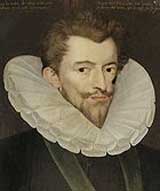The Catholic League
The Catholic League was formed with the purpose of defending the Catholic religion. In the same time, it had a political role, as it was an association of the nobles against the Crown and the Bourbon succession.

Portrait of Henry, Duke of Guise (The Scarred)
by Pierre Dumoûtier
In March, 1585, the great manifesto of the Catholic League was published, expressing also the purpose of the many Leagues in the Provinces. But the typical example, and the most important League, was the Catholic League of Paris. The Catholic League of Paris started with a limited membership of three priests and one layman, an important citizen. Its organization was finalized in 1579. Paris was divided into five districts with five chiefs. The guilds had each a mini League of their own. There was also a subdivision of the city into sixteen constituencies, each of them giving a member to the famous Council of the League, "Les Seize." The Catholic League had secret assemblies, chief among them the Comité de surveillance, whose duty was to spy upon the King. The Sixteen became the ruling force in Paris, reporting directly to Guise.
Between 1579 and 1585, thousands of people from all classes enrolled in the Catholic League. They were gens du Palais, political enthusiasts, bourgeois, artisans, priests, Doctors of the Sorbonne. In the same year 1585, the League had made a secret pact with Spain, the Treaty of Joinville. Signed by all the big French Catholics, the treaty undertook to defend the faith, to eliminate the heretics, and to disinherit Henry de Navarre. It also provided for private bargains with Philip. He promised to send troops, while Guise was to fight the Flemish rebels and to give him Cambrai. Another civil war began.
The Catholic League made gains, and its members offered to lay down the arms, but only if the King granted their conditions. The King had the means to determine a favourable outcome for him, yet he played his cards in a very unskilful manner. When Navarre and the Huguenots approached him, he rejected their offers, simply because he personally did not like them. His next move was to approach the Catholic League, but there nobody trusted him anyway. Only the Catholiques royaux alone remained around him. The members of the League, the Politiques, and the Huguenots (chiefly in the South and West) were now the main parties deciding the game.
One-third of the nobility, which meant one thirtieth of the whole population, had become Huguenots. Many lawyers and Crown officials were among the converts. There was a strong Protestant element in the army. The Politiques expanded considerably, as they managed to include every shade of moderate opinion, from all parties: those who fought for Guise and those who fought against him, the anti-Catholic and the anti-Spanish alike.
In the autumn of 1587 began the so-called War of the Three Henrys (Henry III, Henry de Guise, and Henry de Navarre). After series of successes, Guise marched towards Paris. The concessions that the Duke demanded on behalf of the League, as outlined in the Articles of Nancy, were true insults to the King. The Duke of Guise was now the master of Paris, and he did not intend to stop till he got at least the position of Lieutenant General. He asked for the establishment of the Inquisition in France, the exclusion of Protestants from office, and that all appointments to be made by him. Henry refused to accept.
Catherine de' Medici temporized for as long as she could, but in the end, the King gave in. He would, he said, accept these propositions provided that he might thenceforth dispose of the League, and that Guise would not come to Paris. The Swiss, under the command of d'Épernon, were at the gates of Paris. Making a huge mistake, the King decided to order their entry at this moment, and the arrival of such a considerable force looked as if he feared the population of the city. Rumours began to circulate about the King bringing in the Swiss to butcher the chief Catholics, and that the city would be pillaged. There was a serious revolt of the students, and the whole town deserted the King.
On May 12 1588, Guise masterly staged the "Revolution" of Paris, entrapping the King's troops between the barricades erected by the Catholic League. The Duke occupied the Hotel de Ville and the Arsenal. The King left Paris for Rambouillet, and next day he went to Chartres. In Paris, a provisional government was formed, and on May 28, the Commune was instituted by a Council at the Hotel de Ville.
On July 10, the King signed the Acte d'Union at Rouen, an accord by which the King accepted all the requirements of the Catholic League. The Protestant succession was eliminated. Guise was to be Commander in chief of the army and the heir to the crown. Things could not stay like this for long. The Duke d'Épernon wrote to the King that Guise is involved in a plot against his person. The King decided to assassinate the Duke, as he was convinced that if he does not do it to Guise, Guise will surely do it to him. On 23 December 1588, at Blois, Henry's personal guard, the Forty-Five, struck the Duke with their daggers and swords. With a last effort, the victim dragged himself to Henry's bedroom, and died at the foot of the King's bed.
The leadership of the Catholic League passed to the Duke's brother, the Duke of Mayenne, the commander of the Catholic League troops. The Catholic League was eventually defeated, and Henry IV concluded the peace with Mayenne. The treaty signed in January 1596 put an end to the Catholic League.